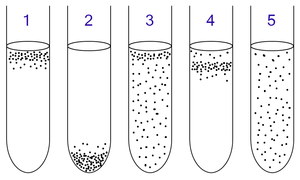
Back جرثوم أليف الهواء القليل Arabic Microaerofília Catalan Mikroaerofil Czech Mikroaerophil German Microaerofilia Spanish Mikroaerofilo Basque خرد هوازی Persian Organisme microaérophile French Microaerófilo Galician מיקרואירופיל HE

1: Obligate aerobes need oxygen because they cannot ferment or respire anaerobically. They gather at the top of the tube where the oxygen concentration is highest.
2: Obligate anaerobes are poisoned by oxygen, so they gather at the bottom of the tube where the oxygen concentration is lowest.
3: Facultative anaerobes can grow with or without oxygen because they can metabolise energy aerobically or anaerobically. They gather mostly at the top because aerobic respiration generates more ATP than either fermentation or anaerobic respiration.
4: Microaerophiles need oxygen because they cannot ferment or respire anaerobically. However, they are poisoned by high concentrations of oxygen. They gather in the upper part of the test tube but not the very top.
5: Aerotolerant organisms do not require oxygen as they metabolise energy anaerobically. Unlike obligate anaerobes however, they are not poisoned by oxygen. They can be found evenly spread throughout the test tube.
A microaerophile is a microorganism that requires environments containing lower levels of dioxygen than that are present in the atmosphere (i.e. < 21% O2; typically 2–10% O2) for optimal growth.[1] A more restrictive interpretation requires the microorganism to be obligate in this requirement.[2][3] Many microaerophiles are also capnophiles, requiring an elevated concentration of carbon dioxide (e.g. 10% CO2 in the case of Campylobacter species).[4]
The original definition of a microaerophile has been criticized for being too restrictive and not accurate enough compared to similar categories. The broader term microaerobe has been coined to describe microbes able to respire oxygen "within microoxic environments by using high-affinity terminal oxidase".[1]
- ^ a b Fuduche, Maxime; Davidson, Sylvain; Boileau, Céline; Wu, Long-Fei; Combet-Blanc, Yannick (19 March 2019). "A Novel Highly Efficient Device for Growing Micro-Aerophilic Microorganisms". Frontiers in Microbiology. 10: 534. doi:10.3389/fmicb.2019.00534. PMC 6434946. PMID 31001208.
- ^ Hogg, S. (2005). Essential Microbiology (1st ed.). Wiley. pp. 91–107. ISBN 0-471-49754-1.
- ^ Prescott LM, Harley JP, Klein DA (1996). Microbiology (3rd ed.). Wm. C. Brown Publishers. pp. 130–131. ISBN 0-697-29390-4.
- ^ Brooks GF, Carroll KC, Butel JS, Morse SA (2007). Jawetz, Melnick & Adelberg's Medical Microbiology (24th ed.). McGraw Hill. pp. 273–275. ISBN 978-0-07-128735-7.